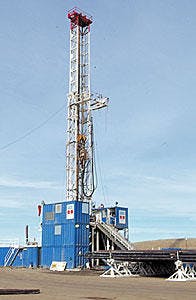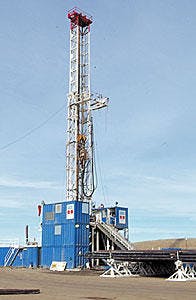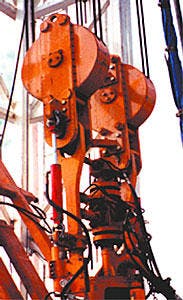Conoco Inc., Houston and Tesco Corp., Calgary, commercialized the Casing-Drilling process by signing a multiyear, multiwell contract, which they say is their first for Casing-Drilling services.
The companies announced in February plans to build three new drilling rigs specifically designed to drill with casing, a technology that Tesco has been developing for the past 5 years. Tesco's Calgary facilities will build the rigs.
Under the $30-million contract, Tesco will operate the three rigs for Conoco to perform a 2 year, development-drilling program in Conoco's South Texas Lobo natural gas trend.
The companies expect the first rig to be operating by Sept. 1, 2002, with the other two rigs starting to work in the Lobo trend by Dec. 31, 2002.
By using standard well casing instead of drill pipe to drill each wellbore section, Casing-Drilling rigs achieve greater efficiency and performance by eliminating time-consuming trips to change drill bits and set casing, according to the companies.
The well casing serves as the drillstring, with the drillbit at the bottom of the casing attached to a wireline-retrievable bottomhole assembly (BHA). Once the rig drills a hole section or if the drillbit becomes worn-out, the rig mounted wireline unit retrieves the BHA, leaving the casing in place (OGJ, May 17, 1999, p. 58).
"The savings and efficiencies the companies expect from the new, built-for-purpose Casing-Drilling rigs significantly exceeds the performance Conoco could achieve with the conventional drilling process," said Bob Tessari, Tesco's president and CEO, in a conference call to industry analysts in February.
Tessari added that the Casing-Drilling technology has been able to drill wells more efficiently, even in light of Conoco's work in optimizing conventional drilling operations in the Lobo with newer and more modern conventional drilling rigs.
In a pilot project with Driller's Technology Corp. of Calgary, Rig No. 4, the companies were in the process of drilling the tenth well at the time of the announcement, with use of the Casing-Drilling process.
According to Tessari, the rig had drilled the wells 20-30% faster than conventional rigs.
Tools, rigs
Casing-Drilling rigs employ split crown blocks, split traveling blocks, wireline BOP integrated into the top drive, wireline winch, and casing-handling equipment (Fig. 1).
The split crown and traveling blocks allow wireline access for running and pulling the BHA as the rig traveling blocks support the casing string (Fig. 2).
The casing-drilling process is safer that the conventional process, primarily because the rigs do not need to trip drill pipe, according to the companies. Casing-Drilling rigs operate with reduced labor, require less horsepower, and have lower capital requirements.
Tesco has developed the tools for casing sizes from 133/8-in. down to 41/2-in., essentially covering the market in terms of days that rigs spend drilling wellbores for those casing strings.
Tessari said, "We've started in the most difficult area, that being 41/2-in. casing."
Crews can run and retrieve the tools without difficulty, but the size has not been able to compete on a penetration rate basis, he added.
The 51/2-in. casing has performed well, in work that Tesco currently has underway with Royal Dutch/Shell Group in the North Sea and in testing at company facilities.
Tessari said, "Of course 7-in. looks very good. I think as we go deeper with 7-in. we certainly have a lot more advantages than the conventional [drilling] process, especially in tripping and the hydraulics."
Tessari added, "If you can run casing that deep, we can drill with it that deep."
The Casing-Drilling process for 95/8-in. casing is going extremely well and that size represents the largest market in the world.
The company said it has developed tools for drilling with 133/8-in. casing, to be deployed to Algeria and the North Sea in 2002, and potentially to Indonesia and the US as well.
According to Tessari, coming up with a very rough number, 70-80% of the drilling market can use the Casing-Drilling technology as we know it today.
Drilling problems solved
Asked if there were geologic structures or geographic areas where the technology would be less applicable, Tessari replied, "We don't know of any right now. When we started, we thought we would do better in soft rock than hard rock."
As it turns out, when applied to hard rock, Casing-Drilling performs better and more efficiently than the conventional process because drillbits wear out more quickly, resulting in more trips. Drilling with casing saves a lot of time in the tripping process.
In Wyoming about 3 years ago, Casing-Drilling tools drilled through rather hard rock, which Tesco defined as having a sonic log velocity less than 70 msec.
Tessari said his company was trying to push the technology into more troublesome areas where drilling with casing not only reduces drilling time by increasing drilling efficiency but also by eliminating unscheduled events such as stuck pipe, lost circulation, and kicks due to swabbing.
He added that his company was working on troublesome wells with Conoco.
Eliminating these unscheduled events was part of their motivation to employ the Casing-Drilling technology.
According to Tessari, in more than 50 wells drilled since Casing-Drilling technology was developed, crews have not had a joint of casing to get stuck, have not had wellbore packing off issues, and generally have not taken kicks.
As more and more drilling engineers from various companies look at the process of drilling with casing, they raise the question of why there are few lost circulation problems.
There should be more lost circulation events than with conventional drilling because the casing-drilling process places more back pressure on the formation.
There appears, however, to be a healing process occurring that closes-off permeability as the bit drills.
Some of the engineers at Conoco have termed it the "smear effect," according to Tessari.
He added that engineers would be presenting a paper on this subject along with various other aspects of the Lobo project in June at the International Association of Drilling Contractors (IADC) World Drilling 2002 conference in Madrid.
Drilling engineers whose companies have spent millions of dollars dealing with lost-circulation problems in a given area may find this extremely exciting if casing drilling could reduce or eliminate the problem.
Casing-Drilling has not suffered the shale-sloughing problems in areas where it has traditionally been a problem, due to continuous circulations and no surge and swab pressures being exerted on formations.
Many drilling engineers link problems causing unscheduled events to the drill pipe beating up the wellbore as it rotates.
Tool joints flop from side to side as the drillstring rotates, damaging the formation face, said Tessari.
This elimination of lost circulation and other unscheduled events has been observed in Casing-Drilling operations with several operators, according to Tessari.
He said the industry would likely publish a lot of technical papers that will try to describe the phenomena downhole.




